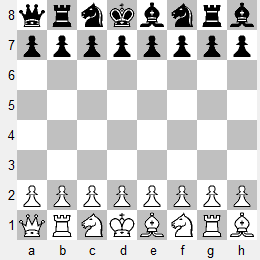As interesting as HarryO's idea is, I believe it has a fatal flaw, which I stated in a comment to that SP395 post:-
I propose we play a two-game match with one of these SPs that you've flagged, where we each take White in one game. In the game where you are White, I will select your first move from your list of viable moves. In the game where I am White, I will choose my first move myself.
Let's return to SP491 and choose a pair of moves for the hypothetical match. I'll begin with the game where I'm playing White.
When I look at a new SP for the first time, I start with the castling choices. In SP491, I see no reason to favor one of the castling options over the other. Castling O-O-O will be possible after the Nc1 moves, while castling O-O requires the Be1 and the Nf1 to move off the back rank.
I adhere to classical opening principles, especially the one about paying attention to the center. For this reason, the moves 1.b4 and 1.g4 don't appeal to me, even though it is often attractive to advance by two ranks the Pawn directly in front of a Rook. On top of ignoring the center, both moves preclude future castling to that wing.
I also don't like developing Knights until I get some idea where they will be most active. In the given position it is too early to decide about the Knights. On top of that, the moves 1.Nd3 and 1.Ne3 leave the Knight exposed to harrassment by the Black center Pawns.
After a few minutes thought, I decided that 1.d4 is my preferred move in this position. It prepares Nc1-Nd3, where the Knight is both centralized and protected, and where castling O-O-O is already possible. As a bonus, the castled Rook would be placed on a partially open file. The move 1.d4 also opens a diagonal for the Bishop on e1, bringing White one step closer to castling O-O.
The downside of 1.d4 is that the Pawn is exposed to attack by the Bishop on h8 and by ...Ne6. After playing with the position a few more minutes, I decided that both of these attacks can be defended in various ways.

SP491 QRNKBNRB
As for choosing a first move for my opponent, my eye immediately jumped to the 12th possibility on the list of viable SP491 moves: 1.h4. HarryO justified this move with the comment, 'it takes control of g5, threatens h5, and allows Nh2/f3', but none of those reasons is particularly compelling. The downside of 1.h4 is that it ignores the center, does nothing to develop a piece, and signals that White will not be castling O-O. Each of those disadvantages is enough to reject the move and taken together they brand 1.h4 as positionally weak.
A skilled chess960 player like GM Nakamura might whip up some serious threats with 1.h4, but he knows more about chess than the average player does. So 1.d4 for me and 1.h4 for my hypothetical opponent, and I'm off to a good start.

No comments:
Post a Comment